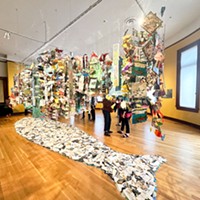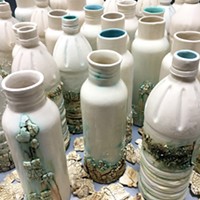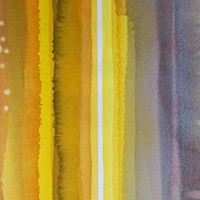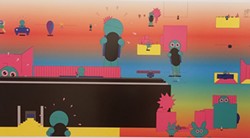Mapping Seven Artists, Seven Paths
A group show reopens at the Morris Graves Museum of Art
By Gabrielle Gopinath[
{
"name": "Top Stories Video Pair",
"insertPoint": "7",
"component": "17087298",
"parentWrapperClass": "fdn-ads-inline-content-block",
"requiredCountToDisplay": "1"
}
]
The exhibition Seven Artists, Seven Paths is back. The exhibition reopens this week at the Morris Graves Museum of Art after a months-long virtual interlude due to pandemic restrictions on social gathering. The seven Humboldt artists whose work it features — Leslie Anderson, Becky Evans, Mimi LaPlant, Sanderson Morgan, John Pound, Emily Silver and Karen Sullivan — are linked through mutual acquaintance as members of a circle that has met for dinner and studio talk every two months for a dozen years. As a celebration of a long-running artists' social network (not the online kind), Seven Artists speaks to the creative potential of the face-to-face social interactions we've all been waiting to resume.
"We're really different people but we can talk to one another easily," emeritus professor and volunteer curator Morgan said. "We're not interested in mutual criticism. What we're interested in is the life of the artist in the studio. When things are good, when things are bad — that's what we talk about." Members' processes differ vastly, he said, but the studio experience is what they have in common: "being alone, and doing all the things necessary for creation."
Drawing on his 25 years of experience as director of Humboldt State University's Reese Bullen Gallery, Morgan brought process into the conversation by inviting artists to show notes, sketches and studio ephemera alongside their finished works. The connections this organizational structure reveals are often illuminating.
Becky Evans' finely calibrated, hand-retouched topographic maps of the forested ridges around Mount Shasta, conceived in relation to a poem by Jerry Martien, explore the possibility of a layered nature/culture laminate. This concept takes on 3-D form in a funnel-shaped sculpture made from a unique, hand-molded paper surface that is part wasps' nest, part USGS map.
Emily Silver's species lists, "intuitive maps" and watercolor sketches of the desert bristle with densely packed annotations of colors and landscape contours. The azure-into-crimson of the western skies over Joshua Tree National Park, painted here at sketchbook scale, relates to larger watercolors that make abstract those tequila sunrise hues and render them at a scale more reminiscent of the actual sky.
Mimi LaPlant's paintings interlace gestural brushstrokes, drips and smears with abstract motifs. Her large painting "Renewal" appears alongside a grid of smaller related studies. This hanging order makes it possible to appreciate the recurrence of certain motifs and hues, like the passages of intense spring green that flicker across several of these compositions and the scallop-like mandala forms that populate their surfaces.
Several of these artists used pandemic studio time to explore new media. Morgan, who worked with photographs in curatorial positions at the Berkeley Art Museum and the Reese Bullen Gallery, shows his own photographs here for the first time. His suite of prints documents the patina of historic locomotives at the Timber Heritage Association's Samoa roundhouse, using saturated color to draw out the oxidized layers that encrust these industrial age relics' weathered surfaces.
Leslie Price shows paintings made from feathered brushstrokes in closely modulated shades of off-white alongside a selection of the ceramic vessels he has begun making in the last few years. It's a treat to see how this veteran abstract painter turns his hand to a new medium, seeking an equivalent for the sense of harmony and balance that animates his canvases in vessel forms.
John Pound has been using computer code to make art since the 1980s. His images are made using programs he developed that position graphics on a field within certain parameters, creating randomized confrontations that look like the outcome of Mad Libs for digital images. This approach results in bright gradients populated with lozenge-shaped characters in absurdist interactions like the ones appearing in Pound's comic, "Electric President."
Karen Sullivan's drawings and paintings also feature images juxtaposed in weird ways — not through the service of an algorithm, but from a daily commitment to notate the movements of the unguarded mind. During the pandemic she's kept her creative process close to home, making daily "telephone doodles" on notes that she later arranges into plastic folders. "Yellow Falls: In the Time of Covid" drapes those notes across the gallery wall, creating a gridded arc that looks a bit like a waterfall running the dull bureaucratic yellow of the basic Post-It note. The shade is comically, unavoidably urinary in this context; the work as a whole is a cheery taking of the piss with regard to the regional tendency to enshrine a certain kind of work — uncomplicated art that gestures enthusiastically toward nature's magnificence.
This exhibition's emphasis on preparatory work speaks to the curator's documentary motivation. Morgan said that he has long taken an interest in "creating a historic record for this little art world we have here; recording what we do and why we do it." He's interested in the networks that have made it possible for these Humboldt artists to thrive, despite the challenges that go along with choosing to base a serious art practice in a remote region that's long on natural splendor, rich in a violent history that cuts close to the bone of the American project, and yet short on capital, institutional support, patrons and exhibition opportunities.
Exhibition staging connects viewers to what happens in these artists' studios but the face-to-face social network that has linked these artists for the past dozen years remains, perhaps inevitably, more a matter of telling than of showing. Reading these artists' statements and viewing their sketches, we connect the dots to hypothesize how individual and group affinities may have shaped the work.
To connect the dots is also to make a kind of map; mapping, Morgan said, is part of what he hopes this exhibition will accomplish. This exhibition maps a single artists' circle. A diligent curator could generate a dozen such parallel micro-histories in other local circles. Then, by connecting all those dots, a viewer might approach an understanding of the complex networks underlying the various forms of this region's — any region's — art.
Morgan was quick to acknowledge the practical difficulties of such endeavors. He brought up Jorge Luis Borges' short story "On Exactitude in Science," about a fictional empire whose rulers have developed cartography so exactly that they are able to make a map the exact size and dimensions of the empire itself. You might think such peerless location services would ensure the regime's longevity but, in fact, decline ensues when future generations lose interest in mapmaking and the massive maps decay, causing so many impediments that the empire collapses into ruin.
This absurdist reduction reminded me of Google Earth and how inhumanly unmanageable that map is at its scale — as opposed to, say, the manageable hugeness of the New York City panorama commissioned by Robert Moses for the 1964 World's Fair, the one Fran Lebowitz bestrides Gulliver-like in Martin Scorsese's 2021 documentary Pretend It's a City. The medium is the message, as all the Boomers out there know: As the machine networks connecting us evolve, the nature of our communication changes in response. If Morris Graves were alive today, instead of writing newsy longhand letters that later generations could comb for insight into his life and art, wouldn't he be sharing fruit emoji and cat memes like the rest of us?
The social cartographer's task is not easy, Morgan agreed, especially not when the terrain in question is an artists' circle. We're talking about a gossamer network constituted through some multi-branched social connections and experiences over time, one that can be described but never reproduced in its totality. The challenge makes a regional exhibit of this kind especially significant. Seven Artists bears witness to a creative social network that has persevered longer than most, through trying times, held together by the delicate yet durable filaments Morgan describes as "mutual respect and delight in one another's company."
"Seven Artists, Seven Paths" reopened to visitors will stay open through May 23 at the Morris Graves Museum of Art.
Gabrielle Gopinath (she/her) is an art writer, critic and curator based in Arcata. Follow her on Instagram at @gabriellegopinath.
Speaking of...
-

The Return of '30,000 Salmon'
Aug 17, 2023 -

We're All Land Artists Now
Oct 31, 2019 -

Salt: Emily Silver and Holly Sepulveda
Jan 31, 2019 - More »
more from the author
-
Nancy Tobin's CRy-Baby Installation at CR
- Feb 22, 2024
-
Truth Units
Bachrun LoMele's Burn Pile/The Andromeda Mirage at the Morris Graves
- Sep 7, 2023
-
Ruth Arietta's Illusory Interiors at Morris Graves Museum of Art
- Aug 10, 2023
- More »

































